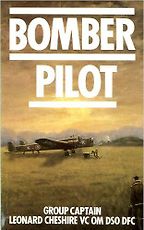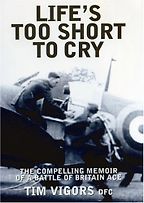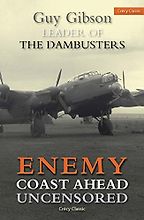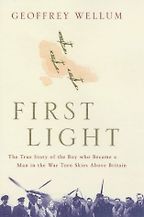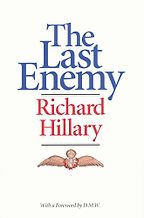Your book Flight Path to Murder recounts the investigation into the brutal murder of a pilot who made an emergency landing on German soil in 1944. How unusual was it for a pilot to be savaged by civilians?
It’s estimated that around 800 Allied airmen were lynched during the Second World War. At the beginning of the war it was not the norm – far from it. Almost everyone at the start had a moral high ground – the RAF, for example, were forbidden to bomb near civilians. However this was steadily eroded and by 1945 there had been massive strategic bombing across Germany, and so any airmen who did come down had the potential to be in serious trouble. And a lot of propaganda had been built up in Germany about the Terrorfliegers [terror fliers]. It got to a point where the Nazi hierarchy told the police not to interfere if civilians were attacking airmen. Unfortunately the pilot Bill Maloney came down somewhere where the people were out for vengeance.
Leonard Cheshire, the author of Bomber Pilot was one of the most highly decorated members of the RAF. He was awarded the Victoria Cross, the Order of Merit and he was made a life peer. Did he take to the skies like a duck to water?
Yes. He was unusual in that his Victoria Cross was awarded for continuous effort and courage, rather than for a particular act of bravery. Cheshire’s decorations reflect his skills to survive – he did some pretty dangerous stuff of course. He starts off as a real novice and gets thrown into all sorts of situations. Cheshire started flying during the early days of bombing – from flying across Germany at night and dropping a few hundred tonnes of bombs, to witnessing the ultimate in strategic bombing, the bombing of Nagasaki.
Witnessing the bombing of Nagasaki must have been…well, indescribable. Is that covered in this book?
No, Bomber Pilot describes the first half of the war – it finishes in 1942 and it was published during the war. I think it’s an important book in that it recalls the early days of the war. A lot has been written about the bombing offensive in the last years of the war, but to fully understand the escalation of the air war you need to appreciate the difficulties faced by the bomber crews in the early stages. Cheshire’s book aptly describes these testing times.
What did you like about it?
I like it because he really puts you in the seat of the cockpit – you’re getting it first-hand from someone who flew the aircraft. And he talks about the losses and how they affected him, though eventually he became quite matter-of-fact about it.
How do you think the pilots coped with their fear of death?
That’s a question I’ve often put to them. Some of them couldn’t cope, though most of them did. The standard answer I’m given is that they thought, ‘It’s not going to happen to me,’ or, ‘I’m just doing a job.’ Some put a barrier up. Some of the terminology they used shows this – if someone was killed, they would say: ‘So and so bought it.’ They used language to put up a barrier rather than acknowledging what was physically happening to human beings.
How many Allied airmen fought and died in the Battle of Britain?
Around 2927 airmen fought, and 544 of those lost their lives. These young men are designated as ‘Churchill’s few’, though there is some controversy around who he included as the ‘few’. I think it could be interpreted as the whole of the RAF, but generally it’s considered that the bomber pilots were ‘the many’. A total of 55,500 were killed in bomber aircraft through the entire war. I don’t think they get the credit they deserve.
Someone such as Tim Vigors, author of Life’s Too Short to Cry, retained his love of flying throughout his life, and even started up the Vigors Aviation company. Others, however, seemed completely traumatised by their experiences. What do you think explains the different outcomes?
That’s right; the pilots came out differently at the end of the war. Vigors maintained a passion for flying, whereas for others it was a job, and when they completed their job and the war was over, some wanted to start families and develop their careers. Some pretty awful things happened during the war and many wanted to put it behind them. However I do think that many pilots never lost their love of flying – but whether this meant in an operational sense for the RAF was a different matter.
What do you like best about Vigors’s book?
His accounts of aerial combat are captivating, and he writes with humility – he is prepared to record the embarrassing mistakes.
Tim Vigors’s book was published 56 years after it was written. It seems extraordinary that an account of such historical significance remained unpublished for so long. What do you regard as the explanation for this?
A lot of these guys were quite modest, and I think they wanted to put their memories down on paper but didn’t want to be accused of shooting a line. The RAF had a culture of not bigging yourself up and I think that still remains. A lot of the veterans I met hadn’t even talked about their experiences, though this often changed once they retired and got in touch with former colleagues from the RAF. I also think there was a swell of interest in their experiences from the public that simply wasn’t there 20 years ago.
Why did you choose to recommend Guy Gibson’s Enemy Coast Ahead?
Because he was probably the most famous bomber pilot of the Second World War.
Could you explain what being a bomber pilot involved, as opposed to a fighter pilot?
A fighter pilot had a single engine aircraft and was fighting against the opposition fighters, and a bomber pilot had a multi-engine aircraft so it wasn’t as easy to manoeuvre. Their purpose was to deliver bombs, which they dropped at night. The bomber pilots were sometimes called the ‘bus drivers’.
What’s significant about Gibson’s account of the Second World War?
He led the famous dams raid, and was subsequently awarded the Victoria Cross, using the ‘bouncing bombs’ in attacks on German dams in May 1943.
The authors of the first two books we discussed managed to survive the war – Gibson, however, was killed. What were the circumstances of his death?
He was insistent that he wanted to go back on operations, following a lecture tour in the United States, though I believe the higher echelons wanted him to stay away from operations. But he went back and ultimately he lost his life in 1944.
Turning to Geoffrey Wellum’s First Light – he was a gifted writer, wasn’t he?
Yes, he’s terrific. He is not a combat hero, an ‘ace’ (someone who has shot down five enemy aircraft), though he was a good pilot. His skill is in taking the reader into the aircraft and giving them the experiences he had.
A third of his book focuses on the training period. How dangerous was training itself?
It was very dangerous and the training period was quite lengthy. The RAF lost over 8,000 men during training for bombers alone.
In his book, Wellum describes the pain he felt when seeing so many friends lose their lives. This eventually caused him to become severely traumatised. Did the RAF provide any emotional support or was that not the done thing back then?
There was no support, which is why they had to develop their own defence systems. But some of them couldn’t cope. The RAF had a term for this – it was called ‘a lack of moral fibre’. If you were branded as having a lack of moral fibre you were basically branded a coward and taken away. That’s why the men developed terms such as ‘bought it’. I remember interviewing one airman who said to me: ‘When someone bought it we went off to the pub and toasted them. What else could we do?’
Why did you choose The Last Enemy by Richard Hillary?
Because it’s an absolute classic of the war. It follows the personal journey that he went through, though it’s a tragic tale. Hillary came from a privileged background to become a pilot, but later he was shot down and suffered very badly from burns. During his long recovery he wrote this book. Nevertheless he maintained a desire to fly and he went back again – and was killed during a training accident.
Get the weekly Five Books newsletter
I understand that Hillary hadn’t properly recovered from his horrific injuries – he had had surgery to give him new eyelids and a new upper lid, among other things. When he returned to flying he still couldn’t hold a knife and fork, yet he was sent out. What was the RAF thinking?
That’s right; he had what was called a ‘clawed hand’ from the burns. I believe, however, that he forced the issue with the RAF.
Have you ever flown in an RAF aircraft?
On my 40th birthday I went up in a Tiger Moth. I felt ill the whole time – the motion sickness was awful. I am, without a doubt, an armchair aviator.
December 8, 2009. Updated: May 10, 2020
Five Books aims to keep its book recommendations and interviews up to date. If you are the interviewee and would like to update your choice of books (or even just what you say about them) please email us at [email protected]
Five Books interviews are expensive to produce. If you've enjoyed this interview, please support us by donating a small amount.
